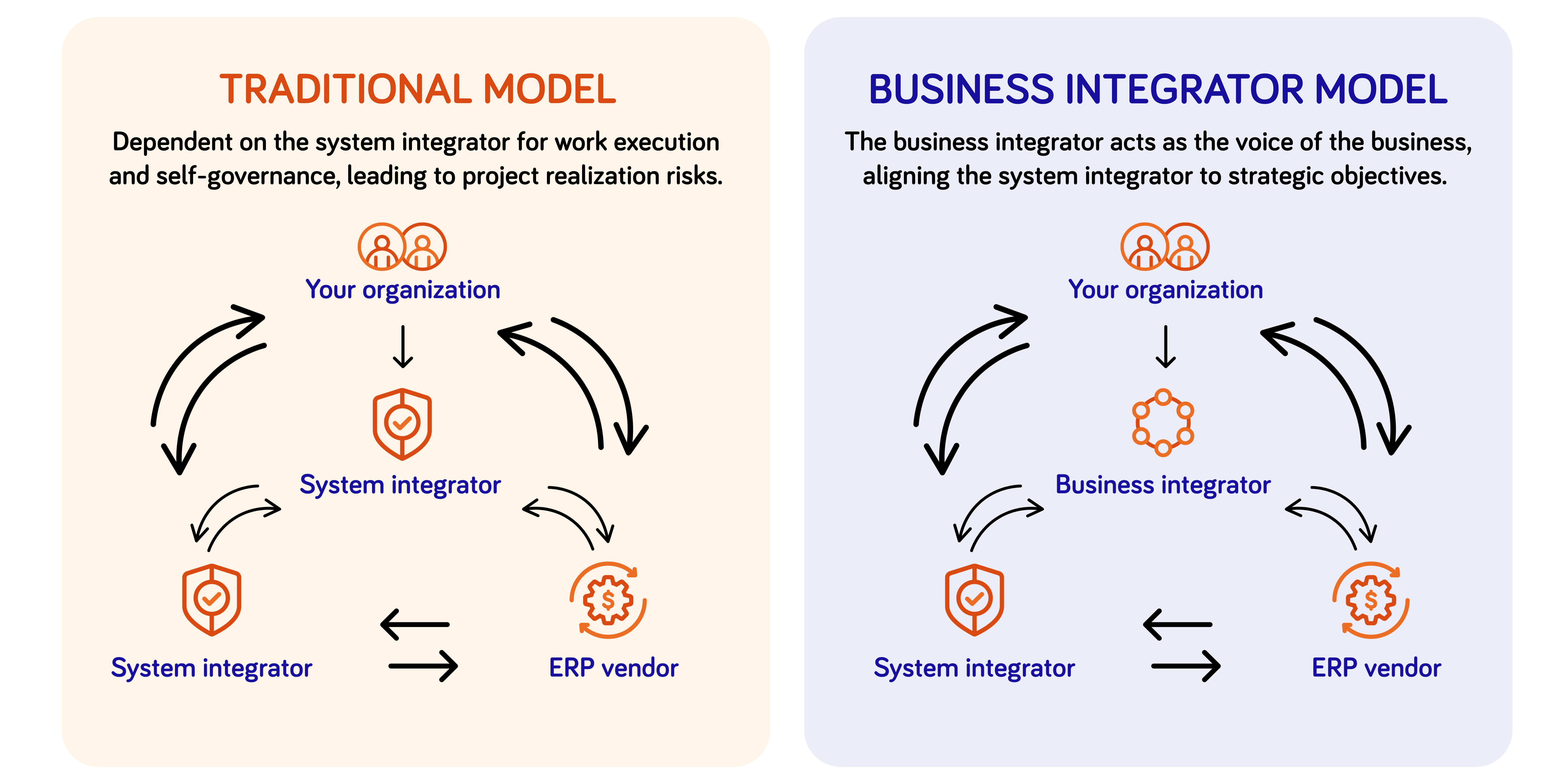The Business Integrator Model
The future of ERP implementation
Clients often come to us frustrated by costly, complex ERP rollouts that fail to deliver. The problem? Traditional implementation methods are outdated—delaying insights, draining ROI, risking compliance, and driving up costs.
Ready for a more successful approach? It starts by doing things differently.
- Poorly designed processes that are misaligned with business objectives
The issue
Your ERP replicates inefficient legacy processes or misfits business needs, limiting transformation benefits and requiring costly workarounds or customizations.
The cost
Low ROI, high maintenance costs, and persistent inefficiencies.
- Insufficient project governance and oversight
The issue
Lack of clear accountability, decision-making authority, and structured project management leads to scope creep, delays, and misalignment with business goals.
The cost
Cost overruns, delays, and misaligned outcomes.
- Weak change management and lack of stakeholder engagement
The issue
Employees resist new processes and systems when not properly engaged or supported, resulting in low adoption and underutilization of the ERP system.
The cost
Poor user adoption, productivity losses, and reduced benefits.
- Inadequate testing and business scenario validation
The issue
Failure to test real-world use cases results in system errors, broken processes, and costly post-implementation fixes.
The cost
Data quality issues, rework costs, and business disruption.
- Limited end-user training and support
The issue
Users are unprepared to effectively operate the new system, leading to mistakes, inefficiency, and increased reliance on IT.
The cost
Errors, productivity losses, and audit and compliance risk.
Put the business in control
Traditional ERP models focus solely on technical delivery and rely on system integrators to both execute and govern—often at the expense of business outcomes. Our modern approach separates governance from execution and places business integrators at the core, ensuring strategic oversight remains with the organization. This shift reduces risk, improves value realization, and addresses the root causes of ERP failure—like poor alignment, weak change management, and low user adoption.

Roles
Your organization
- You define business and technical requirements, building a case for executive support, employee involvement, and a defined scope.
System integrator
- Your expert in deploying and customizing your ERP to meet your business requirements, providing technical support, testing, and training along the way.
ERP vendor
- Develops and supplies the ERP software, provides updates, and offers product support.
Business integrator
- Your key collaborator driving strategic alignment, governance, change management, user adoption, and transparency throughout the project.
3 steps to ERP success
- Step #1 | Align: Put the business in the driver’s seat
We start by embedding governance structures that clearly separate oversight from execution. This ensures the business owns the vision, priorities, and outcomes—while holding delivery partners accountable.
Key activities: Governance setup, stakeholder alignment, delivery framework design.
- Step #2 | Enable: Build the right capabilities and controls
We equip your teams with the tools, roles, and information they need to lead confidently. This includes standing up a Business Integrator function to bridge business and delivery, track performance, and manage change effectively.
Key activities: Business Integrator office setup, PMO and change management integration, risk and issue governance, capability uplift.
- Step #3 | Deliver: Drive execution with transparency and control
As implementation progresses, we keep the business in control—tracking progress, managing partners, ensuring alignment with business objectives, overseeing the end-user experience, and adjusting as needed. Our model prevents vendor overreach and ensures measurable results.
Key activities: Partner oversight, project governance, requirements alignment, end-user experience (testing, training), change management, benefit tracking, value realization.
Want to connect?
Whether you’re unsure of your implementation readiness or you’re mid-implementation and need some extra support, we’re here. We’ll help you focus on the core principles of ERP business integration so you’re set up for success, confident in your journey, and get the most from your transformation.
Fill out the form below and we’ll be in touch!